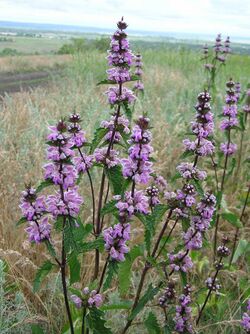Biology:Phlomoides tuberosa
| Phlomoides tuberosa | |
|---|---|

| |
| Scientific classification | |
| Kingdom: | Plantae |
| Clade: | Tracheophytes |
| Clade: | Angiosperms |
| Clade: | Eudicots |
| Clade: | Asterids |
| Order: | Lamiales |
| Family: | Lamiaceae |
| Genus: | Phlomoides |
| Species: | P. tuberosa
|
| Binomial name | |
| Phlomoides tuberosa | |
| Synonyms[1] | |
|
Synonymy
| |
Phlomoides tuberosa (syn. Phlomis tuberosa), the sage-leaf mullein,[2] is a perennial herbaceous flowering plant in the family Lamiaceae, native to China, Kazakhstan, Kyrgyzstan, Mongolia, Russia; SW Asia and Europe. Enlarged, tuberous roots give rise to erect stems to 150 cm bearing purple-red flowers.[3]
Chemistry
Phytochemical analyses of Phlomoides tuberosa leaves have found flavonoids apigenin, apigenin-7-O-glucuronide, luteolin, luteolin-7-O-glucoside, luteolin-7-О-glucuronide, orientin, isoorientin,[4][5][6][7] phenylpropanoids acteoside (verbascoside), forsythoside B,[8] decaffeoyl-acteoside, leucosceptoside A, marthynoside, neolignanes,[9] iridoids sesamoside, 5-desoxy-sesamoside, shanzhiside methyl ester, lamalbide,[10] 8-O-acetyl-shanzhiside, phloyoside I, chlorotuberoside,[9] sterols, triterpenes oleanolic acid, ursolic acid.[11] Dried leaves of plants collected in Buryatia yielded 0.02% of essential oil with a weak aroma with dominant phytol, linalool, eugenol and caryophyllene oxide.[12] The seed has yielded 11.8% of oil, including 3.3% gadoleic acid and some fatty acids containing the unusual allene group, 25.1% laballenic acid and 2.9% phlomic acid.[13] The roots shown the presence of oligosaccharides raffinose, stachyose, verbascose, flavonoids luteolin, linarin, quercitrin, phenylpropanoids acteoside, isoacteoside (isoverbascoside), forsythoside B, chlorogenic acid, decaffeoyl-acteosyde, iridoids shazhiside methyl ester, 8-O-acetyl-shanzhiside methyl ester, 8-O-acetyl-shanzhigenin methyl ester, floyoside I, phlotuberosides I and II, phlorigidoside C, diterpenes (abietanes, labdanes).[14][15]
Cultivation
This plant is grown in full sun, but may tolerate some shade.[2] The cultivar 'Amazone' has won the Royal Horticultural Society's Award of Garden Merit.[16]
Uses
The Kalmyks are said to have eaten the cooked root, calling the plant bodmon sok.[17] Another source for Mongolia has the plant used as a folk restorative medicine against intoxication, tuberculosis, pulmonary and cardiovascular diseases and rheumatoid arthritis.[14] Buryat lamas used some part of the plant to treat diarrhoea, eye and lung disease and as a sedative.[12]
Gallery
Edible tuberous roots: Kalmyk: bodmon sok
References
- ↑ The Plant List, Phlomoides tuberosa (L.) Moench
- ↑ Jump up to: 2.0 2.1 "Phlomoides tuberosa". RHS. https://www.rhs.org.uk/plants/504476/phlomoides-tuberosa/details.
- ↑ "Flora of China". Flora of China Project. http://www.efloras.org/florataxon.aspx?flora_id=2&taxon_id=200020019.
- ↑ Glyzin, V. I.; Peshkova, V. A.; Khokhrina, T. A. (November 1972). "Luteolin 7-β-D-glucosiduronic acid from Phlomis tuberosa". Chemistry of Natural Compounds 8 (6): 785. doi:10.1007/BF00564614. ISSN 0009-3130.
- ↑ Vavilova, N. K.; Gella, É. V. (March 1973). "Homoorientin from Phlomis tuberosa". Chemistry of Natural Compounds 9 (2): 282. doi:10.1007/BF00563376. ISSN 0009-3130.
- ↑ Vavilova, N. K.; Gella, É. V. (March 1973). "Flavonoids from Phlomis tuberosa". Chemistry of Natural Compounds 9 (2): 147–149. doi:10.1007/BF00563331. ISSN 0009-3130.
- ↑ Khokhrina, T. A.; Peshkova, V. A.; Glyzin, V. I. (November 1973). "Flavonoids from Phlomis tuberosa". Chemistry of Natural Compounds 9 (6): 769. doi:10.1007/BF00565810. ISSN 0009-3130.
- ↑ Ersöz, Tayfun; Ivancheva, Stefanka; Akbay, Pinar; Sticher, Otto; Çalış, İhsan (2001-10-01). "Iridoid and Phenylethanoid Glycosides from Phlomis tuberosa L.". Zeitschrift für Naturforschung C 56 (9–10): 695–698. doi:10.1515/znc-2001-9-1004. ISSN 1865-7125. PMID 11724370.
- ↑ Jump up to: 9.0 9.1 Calis, Ihsan; Kirmizibekmez, Hasan; Ersoz, Tayfun; Dönmez, Ali A.; Gotfredsen, Charlotte H.; Jensen, Søren R. (2005-12-01). "Iridoid Glucosides from Turkish Phlomis tuberosa". Zeitschrift für Naturforschung B 60 (12): 1295–1298. doi:10.1515/znb-2005-1214. ISSN 1865-7117.
- ↑ Alipieva, Kalina Iv.; Jensen, Soren R.; Franzyk, Henrik; Handjieva, Nedjalka V.; Evstatieva, Ljuba N. (2000-04-01). "Iridoid Glucosides from Phlomis tuberosa L. and Phlomis herba-ventis L.". Zeitschrift für Naturforschung C 55 (3–4): 137–140. doi:10.1515/znc-2000-3-402. ISSN 1865-7125. PMID 10817200.
- ↑ Janicsák, Gábor; Veres, Katalin; Zoltán Kakasy, András; Máthé, Imre (May 2006). "Study of the oleanolic and ursolic acid contents of some species of the Lamiaceae". Biochemical Systematics and Ecology 34 (5): 392–396. doi:10.1016/j.bse.2005.12.004.
- ↑ Jump up to: 12.0 12.1 Olennikov, D.N.; Dudareva, L.V.; Tankhaeva, L.M. (2010). "Chemical Composition of essential oils from Galeopsis bifida and Phlomoides tuberosa". Chemistry of Natural Compounds 46 (2): 316–318. doi:10.1007/s10600-010-9602-9. https://www.researchgate.net/publication/226658573. Retrieved 9 December 2016.
- ↑ Aitzetmüller, Kurt; Tsevegüren, Nanzad (1998). "Phlomic Acid in Lamioideae Seed Oils". Lamiales Newsletter (Kew) (6): 13–16. http://www.rjb.csic.es/jardinbotanico/ficheros/documentos/pdf/pubinv/JLF/LABLectin-LaNews1998.pdf. Retrieved 9 December 2016.
- ↑ Jump up to: 14.0 14.1 Yang, Yingbo; Gu, Lihua; Xiao, Ying; Liu, Qing; Hu, Haijun; Wang, Zhengtao; Chen, Kaixian (2015). "Rapid Identification of α-Glucosidase Inhibitors from Phlomis tuberosa by Sepbox Chromatography and Thin-Layer Chromatography Bioautography". PLOS ONE 10 (2): e0116922. doi:10.1371/journal.pone.0116922. PMID 25658100.
- ↑ Olennikov, D. N.; Chirikova, N. K. (March 2017). "Phlotuberosides I and II, New Iridoid Glycosides from Phlomoides tuberosa". Chemistry of Natural Compounds 53 (2): 269–272. doi:10.1007/s10600-017-1968-5. ISSN 0009-3130.
- ↑ "Phlomis tuberosa 'Amazone'". RHS. https://www.rhs.org.uk/Plants/72387/Phlomis-tuberosa-Amazone/Details.
- ↑ Pickering, Charles (1879). Chronological History of Plants. Boston: Little, Brown, and Company. p. 793. https://www.biodiversitylibrary.org/item/115487#page/821/mode/1up. Retrieved 8 December 2016.
Wikidata ☰ Q160078 entry
 |


















